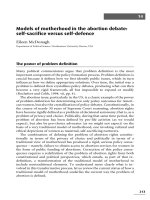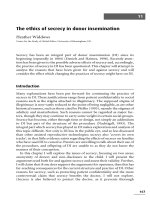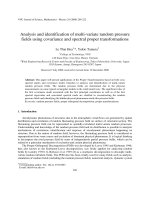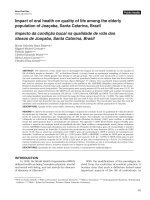Identification of polymorphisms in the nuclear receptors (PXR, CAR and HNF4X) genes in the local population
Bạn đang xem bản rút gọn của tài liệu. Xem và tải ngay bản đầy đủ của tài liệu tại đây (821.61 KB, 110 trang )
IDENTIFICATION OF POLYMORPHISMS IN THE NUCLEAR
RECEPTORS (PXR, CAR AND HNF4α) GENES IN THE LOCAL
POPULATION
HOR SOK YING
NATIONAL UNIVERSITY OF SINGAPORE
2007
ACKNOWLEDGEMENTS
I would like to thank my supervisor, Dr Theresa Tan, for her invaluable ideas,
suggestions and contributions for this project. Not to mention the countless amendments
for both my manuscript and thesis. Thanks for being so understanding and patient with
me all these years.
I would like to thank HaoSheng, Li Yang, Weiqi, Bai Jing, Yang Fei, Jasmine, and
Thomas for all the helps, suggestions and countless ideas for my project. For that and
much, much more I am extremely grateful. Thanks for being such great friends.
Most importantly, I would like to thank my husband, Dewayne, for being so supportive
and encouraging throughout my course of study. A big “Thank You” for my parents and
parents-in-law for all the help they have rendered to me.
Great thanks also go to: Dr Goh Boon Cher and Dr Lee Soo Chin for their precious
samples and suggestions; Lai San, for helping me with all the statistical analysis; Huiling
and Jiayi, for helping me with BigDye sequencing; and Rex, for helping me with
Pyrosequencing.
I am also grateful to the followings for permission to reproduce copyright material:
Elsevier
Lippincott & Williams Wilkins
The American Association for the Advancement of Science
And lastly, I would like to thank Biomedical Research Council of Singapore (BMRC
01/1/26/18/060) for their generosity in supporting this work.
i
TABLE OF CONTENTS
Acknowledgements…………………………………………………………………….. i
Summary……………………………………………………………………………….. iv
List of Tables…………………………………………………………………………... vi
List of Figures………………………………………………………………………….. viii
List of Abbreviations…………………………………………………………………... x
1.
Introduction……………………………………………………………………. 1
1.1 Drug Metabolism and Disposition…………………………………………1
1.2 Cytochrome P450………………………………………………………….4
1.2.1
CYP3A…………………………………………………………….. 8
1.2.2
CYP3A4……………………………………………………………10
1.2.3
CYP3A5……………………………………………………………12
1.2.4
CYP3A7……………………………………………………………12
1.2.5
CYP3A43…………………………………………………………..13
1.3 Nuclear Receptor………………………………………………………….14
1.3.1
Pregnane X Receptor………………………………………………17
1.3.2
Constitutive Androstane Receptor…………………………………18
1.3.3
Hepatocyte Nuclear Receptor 4-alpha……………………………..19
1.4 Regulation of CYP3A4 Expression by PXR, CAR and HNF4α………….23
1.5 Docetaxel………………………………………………………………….26
1.5.1
2.
Docetaxel Metabolism and Elimination Pathway…………………28
Objectives and Overview of the Study………………………………………...31
ii
3.
Materials and Method…………………………………………………………..35
3.1 Materials…………………………………………………………………...35
3.2 Methods……………………………………………………………………36
4.
3.2.1
Study Population………………………………………………….. 36
3.2.2
Genotyping…………………………………………………………38
3.2.3
Alignment of Sequences……………………………………………46
3.2.4
Statistical Analysis………………………………………………… 47
Results…………………………………………………………………………..49
4.1 Screening of PXR, CAR and HNF4α Genes in Local Healthy Population...49
4.1.1
Amplification of Exons and Sequencing…………………………...49
4.1.2
Variants in the PXR, CAR and HNF4α Genes……………………...53
4.2 Screening of PXR, CAR and HNF4α Genes in the Breast Cancer
Population………………………………………………………………….60
4.3 Comparing the Allele Frequencies between Local Healthy and
Breast Cancer Population………………………………………………….63
4.4 Pharmacokinetics Correlations……………………………………….……64
5.
Discussion……………………………………………………………………... 75
5.1 Exonic Variants in PXR, CAR and HNF4α genes…………………………76
5.2 PXR, CAR and HNF4α Genotypes and Docetaxel Pharmacokinetics…….79
6.
Conclusion …………………………………………………………………….81
7.
Publications…………………………………………………………………….82
8.
References……………………………………………………………………...83
iii
SUMMARY
The nuclear receptor (NR) superfamily is a large class of pharmacologically important
receptors that play vital roles in the defence mechanisms in the human body. It is
responsible for protecting the body from a diverse array of harmful endogenous and
exogenous toxins by modulating the expression of the genes involved in drug metabolism
and disposition. The detoxifying and elimination of these toxins is mainly mediated by
cytochrome P450 (CYP) enzymes, along with phase I and phase II drug metabolising
enzymes, as well as drug transporters.
Three closely related nuclear receptors, namely the pregnane X receptor (PXR),
constitutive androstane receptor (CAR) and hepatocyte nuclear factor 4-alpha (HNF4α)
have recently been identified as the master transcriptional regulators of CYPs expression.
The human CYP3A sub-family collectively comprises the largest portion of CYP
proteins expressed in the liver and they are involved in the metabolism of more than 60%
of all currently prescribed drugs. CYP3A4, the most abundantly expressed CYP3A
isoform, is considered as the main oxidase for these drugs in the liver. In recent years,
much work had been carried out to identify single nucleotide polymorphisms (SNPs) in
the three receptor genes (PXR, CAR and HNF4α) and to examine the significance of
these SNPs in relation to CYPs expression in terms of drug disposition or responsiveness.
It is hypothesized that genetic variation in these nuclear receptors may contribute to
human inter-individual variation in drug metabolism and also drug-drug interactions.
iv
The first part of this study aims to identify SNPs in the exons of the PXR, CAR and
HNF4α genes in the local healthy population. We identified a 5’ UTR variant for the
PXR gene (- 24381 A > C), one variant for the CAR gene (Pro180Pro) and two coding
variants for the HNF4α gene (Met49Val and Thr130Ile). The second part of this study
was conducted to screen for SNPs in breast cancer patients administered with docetaxel
in their chemotherapy treatment. The objective of the second study was to address the
clinical significance of the SNPs identified in the receptor genes in relation to docetaxel
kinetics. Docetaxel is an anti-cancer agent that is metabolised by CYP3A4. Thus, any
SNPs in these receptor genes could possibly affect docetaxel clearance in the breast
cancer patients. From our data, the same four variants were again identified in the breast
cancer cohort. No additional SNP was observed. Statistically, no significant correlation
was noted for the docetaxel clearance, body-surface-area normalised docetaxel clearance,
area under curve and half-life for PXR, CAR and HNF4α genes. In conclusion, the SNPs
identified in the PXR, CAR and HNF4α genes in this study appear not to have any
significant contribution to the variability in docetaxel clearance among the breast cancer
patients.
v
LIST OF TABLES
Table 1
Summary of the major drug metabolising cytochrome P450 enzymes,
their main tissue localisation and the anti-cancer agents which
they metabolise……………………………………………………………. 6
Table 2
Summary of the tissue distribution and type of reactions catalyzed by
some human cytochrome P450 enzymes involved in the maintenance
of cellular homeostasis……………………………………………………. 7
Table 3
List of reagents needed for this study and the suppliers………………….. 35
Table 4
A set of PCR forward and reverse primers that were used to amplify
each individual exonic region of the PXR gene…………………………. 40
Table 5
A set of PCR forward and reverse primers that were used to amplify
each individual exonic region of the CAR gene……………………….… 41
Table 6
A set of PCR forward and reverse primers that were used to amplify
each individual exonic region of the HNF4α gene……………………… 42
Table 7
Forward and reverse primers for pyrosequencing………………………. 45
Table 8
Polymorphisms identified in the PXR, CAR and HNF4α gene in the
healthy control population (n = 287)…………………………………… 56
Table 9
Genotypic distribution and allele frequencies of PXR, CAR
and HNF4α variants in healthy control………………………………... 57
Table 10 Comparison of SNP frequencies of PXR exon 1 variant……………… 58
vi
Table 11 Comparison of SNP frequencies of CAR exon 5 variant……………… 58
Table 12 Comparison of SNP frequencies of HNF4α exon 1C variant…………. 59
Table 13 Comparison of SNP frequencies of HNF4α exon 4 variant……………59
Table 14 Genotypic distribution and allele frequencies of PXR, CAR
and HNF4α variants in breast cancer patients (n = 101)……………….61
Table 15 Genotypic distribution and allele frequencies of PXR, CAR
and HNF4α for the different ethnic groups in the breast cancer
population (n = 101)………………………………………………….. 62
vii
LIST OF FIGURES
Figure 1
Pie chart illustrations of phase I and phase II drug metabolising
enzymes……………………………………………………………….. 3
Figure 2
The schematic organization of the human CYP3A locus………………9
Figure 3
Transcription factor binding sites within the regulatory regions
of human CYP3A4 gene……………………………………………….11
Figure 4
Structure of a typical nuclear receptor……………………………….. 15
Figure 5
The structure of HNF4α gene and its spliced isoforms……………… 22
Figure 6
An illustration of the effects of docetaxel in tumour cell……………. 27
Figure 7
Proposed metabolic pathways of docetaxel by CYP3A enzymes…... 30
Figure 8
A summary of the functions of PXR, CAR and HNF4α in drug
detoxification and elimination………………………………………. 33
Figure 9
Flow chart showing the study approach to identify PXR, CAR
and HNF4α SNPs in healthy subjects and breast cancer patients….. 34
Figure 10 The principle of Pyrosequencing……………………………………..44
Figure 11 PCR amplification of all nine PXR exons from patient genomic
DNA……………………………………………………………….... 50
Figure 12 PCR amplification of all eight CAR exons from patient genomic
DNA………………………………………………………………… 50
viii
Figure 13 PCR amplification of all twelve HNF4α exons from patient
genomic DNA…………………………………………….……….... 51
Figure 14 PCR amplification of PXR exon 1, CAR exon 5, HNF4α
exon 1C and HNF4α exon 4 from patient genomic DNA using
Pyrosequencing primers……….…………………………….……... 51
Figure 15 Electropherograms of PXR, CAR and HNF4α SNPs……….….….. 52
Figure 16 Docetaxel clearance (L/h/m2) against PXR exon 1, CAR
exon 5, HNF4α exon 1C and HNF4α exon 4 genotypes...………... 66
Figure 17 BSA normalised docetaxel clearance (L/h/m2) against PXR
exon 1, CAR exon 5, HNF4α exon 1C and HNF4α exon 4
genotypes…………………………………………………………... 68
Figure 18 Maximum concentration of docetaxel, Cmax, (mg/L) against
PXR exon 1, CAR exon 5, HNF4α exon 1C and HNF4α exon 4
genotypes……………………………………………………………70
Figure 19 Area under curve, AUC, (mg/L*h) against PXR exon 1, CAR
exon 5, HNF4α exon 1C and HNF4α exon 4 genotypes………..… 72
Figure 20 Half life, t1/2, (hours) against PXR exon 1, CAR exon 5, HNF4α
exon 1C and HNF4α exon 4 genotypes…………………………… 74
ix
LIST OF ABBREVIATIONS
ADH
Alcohol dehydrogenase
AF-1
Activation function 1
AF-2
Activation function 2
ALDH
Aldehyde dehydrogenase
APS
Adenosine 5’ phosphosulfate
AUC
Area under the concentration-time curve
Bp
Base pair
CAR
Constitutive androstane receptor
CCD
Charged coupled device
CL
Clearance
CLEM
Constitutive liver enhancer module
Cmax
Maximum concentration
COMT
Catechol O-methyl-transferase
CRE
cAMP response element
CYP
Cytochrome P450
CYPOR
cytochrome P450 oxidoreduactase
DBD
DNA binding domain
DME
Drug metabolizing enzyme
dNTP
Deoxyribonucleotide triphosphate
DPD
Dihydropyrimidine dehydrogenase
DR
Direct repeat
ER
Everted repeat
EST
Expressed-Sequence Tag
GRE
Glucocorticoid responsive element
GST
Glutathione S-transferase
HMT
Histamine methyl-transferase
HNF4α
Hepatocyte nuclear factor 4- alpha
HSP
Heat shock protein
Ile
Isoleucine
x
IR
Inverted repeat
k
Elimination rate constant
LBD
Ligand binding domain
Met
Methionine
MDR
Multidrug resistance
MODY
Maturity-onset diabetes in the young
MRP
Multidrug resistance associated protein
NADPH
Nicotinamide adenine dinucleotide
NAT
N-acetyl-transferase
NHR
Nuclear hormone receptor
NQO1
NADH:quinone oxidoreductase or DT diaphorase
NR
Nuclear receptor
NUMI
National University Medical Institute
OATP
Organic anion transporter
PAR
Pregnane activated receptor
PCN
Pregnenolone 16α-carbonitrile
PCR
Polymerase chain reaction
P-gp
P-glycoprotein
PPi
pyrophosphate
Pro
Proline
PXR
Pregnane X-receptor
RE
Response element
RORα
Retinoic acid receptor alpha
RXR
Retinoid X receptor
SAP
Shrimp Alkaline Phosphatase
SNP
Single nucleotide polymorphism
ST
Sulfotransferase
SULT
Sulfotransferase
SXR
Steroid and xenobiotic receptor
t1/2
Half life
TAE
Tris-Acetate-EDTA
xi
Thr
Threonine
TPMT
Thiopurine methyl-transferase
UGT
Uridine 5’-triphosphate glucuronosyltransferases.
USF-1
Upstream stimulatory factor 1
UTR
Untranslated region
Val
Valine
XREM
Xenobiotic-responsive enhancer module
xii
1.
INTRODUCTION
1.1
Drug Metabolism and Disposition
The body’s first line of defence against the accumulation of potential toxic
endogenous and exogenous lipophilic compounds is the liver. This is the site
where drugs and toxic xenobiotics are being transformed to less toxic water
soluble metabolites that subsequently can be excreted out of the body. In multicellular organisms, two different defence mechanisms have evolved for this
purpose, biotransformation and transport. Biotransformation and transport
processes comprise three phases; phase I (functional reaction) and phase II
(conjugative reaction) form the biotransformation or drug metabolism pathway
while phase III forms the drug transportation and disposition pathway (Gibson
and Skett, 2001).
The phase I enzymes are responsible for primary modification of lipophilic
compounds into more polar forms. Phase I reactions generally include oxidation,
reduction, hydrolysis, hydration, dethioacetylation and isomerisation. On the other
hand, Phase II reactions include glucuronidation, glycosidation, methylation, Nacetylation, sulfation, amino acid and glutathione conjugation. (Gibson and Skett,
2001; Handschin and Meyer, 2003) Phase II comes into play by acting on phase I
metabolites or on the parent compounds to further convert or detoxify to inactive
derivatives, which accounts for bulk of the excreted products. Thus, phase II
1
reactions are considered the true “detoxification” pathway. However, there are
instances where phase II reactions lead to reactive metabolites. Phase III
comprises the transport and elimination steps where the parent drug and its
metabolites are exported out of the cell and eventually removed from the body
through the bile or urine. Figure 1 illustrates the contribution of phase I and phase
II enzymes to the metabolism of drugs.
2
Figure 1: Pie chart illustrations of phase I and phase II drug metabolising
enzymes. The relative size of each section on the charts show the relative
contribution of each phase I and phase II enzymes to drug metabolism. Phase I
enzymes are responsible for modification of functional groups and phase II is
involved in conjugation with endogenous substituents. ADH, alcohol
dehydrogenase; ALDH, aldehyde dehydrogenase; CYP, cytochrome P450; DPD,
dihydropyrimidine dehydrogenase; NQO1, NADH:quinone oxidoreductase or
DT diaphorase; COMT, catechol O-methyl-transferase; GST, glutathione Stransferase; HMT, histamine methyl-transferase; NAT, N-acetyl-transferase;
STs, sulfotransferase; TPMT, thiopurine methyl-transferase; UGTs, uridine 5’triphosphate glucuronosyltransferases. Adapted from Evans and Relling, 1999,
with permission from The American Association for the Advancement of
Science.
3
1.2
Cytochrome P450
Cytochrome P450 (CYPs) enzymes were first discovered in 1958 by Martin
Klingenberg while studying the spectrophotometric properties of rat liver
microsomal pigments. The name P450 was derived from the property of these
pigments which has a maximum absorbance reading at 450nm (Hasler et al.,
1999). CYPs constitute a superfamily of heme-thiolate containing proteins that
belong to a group of enzymes involved in hepatic detoxification of endogenous
and exogenous compounds (phase I enzymes). CYP, together with its reducing
counterpart nicotinamide adenine dinucleotide (NADPH) - cytochrome P450
oxidoreductase (CYPOR), is able to catalyze mono-oxygenase reactions with
lipophilic compounds by allowing the attachment of a hydroxyl group as a
reactive group that can later be modified by phase II enzymes (Handschin and
Meyer, 2003).
CYPs play an important role in the maintenance of the human cellular
homeostasis. Predominately express in the human liver, CYPs metabolize a wide
spectrum of endogenous steroid hormones, bile acids, fatty acids and xenobiotic
substrates such as drugs, carcinogens, food additives, pollutants and
environmental chemicals.
In human beings, there are 18 known CYP gene families and 43 subfamilies
(Kretschmer and Baldwin, 2005; Nelson DR, 2003). Only three of these, CYP1,
4
CYP2 and CYP3, are actively involved in drugs and xenobiotics metabolism.
Members of CYP1A, CYP2B, CYP2C and CYP3A gene subfamilies are highly
inducible by a diverse array of xenobiotics (Handschin and Meyer; 2003). Besides
being involved in drug metabolism, these CYPs also play an important role in
cholesterol biosynthesis, vitamin D metabolism, bile acid metabolism,
biosynthesis and catabolism of steroids (Pascussi et al., 2003; Nelson DR, 1999).
In the CYP family, the major isoforms responsible for drug metabolism are
CYP2C9, CYP2C19, CYP2D6 and CYP3A4 (Ingelman-Sundberg, 2004). Table 1
shows the main tissue localisation of these CYPs and their anti-cancer substrates
(Ingelman-Sundberg, 2004; Van Schaik, 2005).
Different forms of CYP are found to be expressed in intestine, lung and kidneys
but the liver is the major site for CYP-mediated oxidative metabolism, with
CYP3A family as the dominant class. In this study, the focus will be on the
CYP3A sub-family members. This is because of their dominant role in drug
metabolism in the liver, and their regulation by nuclear receptors. Table 2 shows
the reactions catalysed by CYPs in humans and their tissue localization.
5
Cytochrome P450
Main Tissue
Enzyme
Localisation
CYP2C9
CYP2C19
CYP2D6
Liver
Liver
Liver
Anti-cancer Agent
Cyclophosphamide
Tamoxifen
Ifosfamide
Tegafur
Thalidomide
Ifosfamide
Cyclophosphamide
Tamoxifen
Tamoxifen
Gefitinib / Iressa
CYP3A4
Liver
Intestine
Cyclophosphamide
Imatinib / Gleevec
Ifosfamide
Irinotecan
Docetaxel
Paclitaxel / Taxol
Etoposide
Teniposide
Flutamide
Tamoxifen
Gefitinib / Iressa
Vinca-alkaloids
Table 1: Summary of the major drug metabolising cytochrome P450 enzymes,
their main tissue localisation and the anti-cancer agents which they metabolise.
Adapted from Ingelman-Sundberg, 2004; Van Schaik, 2005.
6
Tissue
Liver and Intestine
Function
(i)
Bile acid formation
(ii)
Polyunsaturated fatty acid epoxidation
(iii) Xenobiotic metabolism
► N- & O-dealkylations
► Alcohol oxidation
► Alkane & Arene oxygenation
► Aromatic hydroxylation
Kidney
(i)
Omega hydroxylation of fatty acids
Adrenal
(i)
21-OH of Progesterone
Placenta
(i)
17α-OH of Pregnenolone
Ovary
(i)
Aromatase
Table 2: Summary of the tissue distribution and type of reactions catalyzed by
some human cytochrome P450 enzymes involved in the maintenance of cellular
homeostasis. Reactions include (a) synthesis and degradation of prostaglandins
and other unsaturated fatty acids, (b) metabolism of cholesterol to bile acids and
(c) metabolism of endogenous and exogenous compounds (Hasler et al., 1999)
7
1.2.1
CYP3A
The human CYP3A sub-family is relatively small, comprising only four members;
CYP3A4, CYP3A5, CYP3A7 and CYP3A43 which are mapped on human
chromosomal position 7q21-q22.1 (Figure 2) (Gellner et al., 2001; Plant, 2007).
CYP3As can be induced by a large array of compounds. These include naturally
occurring and synthetic glucocorticoids, pregnane compounds such as
pregnenolone 16α-carbonitrile (PCN) and macrolide antibiotics like rifampicin
(Quattrochi and Guzelian, 2001). Inter-individual variability in induction of
CYP3A activity by these compounds could be due to the genetic variation of
CYP3A sub-family members or its transcription regulators. To date, the number of
variants for CYP3A4, 3A5, 3A7 and 3A43 are 40, 24, 7 and 5 respectively. This
information is published on the official allele nomenclature committee website
(http:www.imm.ki.se/CYPalleles) (Plant, 2007).
As the most abundantly expressed CYP3A isoform in the human liver and
intestine, CYP3A4 is one of the best studied member of the CYP3A gene subfamily. CYP3A4 plays a crucial role in the metabolic elimination of a broad range
of structurally diverse substrates and thus contributes critically to the first-pass
and systemic metabolism in the human body.
8
CYP3A43
CYP3A4
CYP3A7
CYP3A5
Figure 2: The schematic organization of the human CYP3A locus. The assembled 231kb
sequence contains the four CYP3A sub-family members, CYP3A4, CYP3A5, CYP3A7 and
CYP3A43. This cluster is localised on chromosome 7q21-7q22.1 (Burk and Wojnowski,
2004; Finta and Zaphiropoulos, 2000). Both CYP3A4 and CYP3A5 genes contain 502
amino acids each and they have molecular weights of 57299 Dalton and 57109 Dalton
respectively. CYP3A7 and CYP3A43 genes each contain 503 amino acids with molecular
weights of 57526 Dalton and 57670 Dalton respectively. This information is published on
.
9
1.2.2
CYP3A4
CYP3A4 is most abundantly expressed in the liver and small intestine. Accounting
for 30-40% of the total CYPs in the liver, CYP3A4 is considered as the main
oxidase for xenobiotics in this organ. It is catalytically effective on cyclosporine,
macrolide antibiotics, anti-cancer agents such as taxol and is responsible for the
metabolism of more than 60% of the prescribed drugs marketed today (Hasler et
al., 1999; Kretschmer and Baldwin, 2005; Plant, 2007). CYP3A4 is also expressed
weakly in stomach, colon, lung and adrenal (Guengerich, 2005).
Other than its own genetic variations that could possibly contribute to intervariation in drug metabolism, genetic variation in its regulatory transcriptional
partners could also affect how efficiently the gene is transcribed and expressed.
This would eventually have an impact on drug clearance processes, which is an
important determinant of drugs efficacy and toxicity. In recent studies, pregnane
X-receptor (PXR), constitutive androstane receptor (CAR) and hepatocyte nuclear
factor 4- alpha (HNF4α) have been identified to serve key roles in regulating
CYP3A4 transcription (Quattrochi and Guzelian, 2001; Burk and Wojnowski,
2004). This seems reasonable as PXR, CAR and HNF4α binding sites have been
revealed in the CYP3A4 gene (Figure 3) and would be further discussed in Section
1.4 Thus, any variability in these transcriptional controls could also either upregulate or down-regulate CYP3A4 activity.
10
-11400
HNF 4
HNF 1
HNF 4
E-Box
(USF1)
E-Box
(USF1)
CRE
(AP-1)
E-Box
(USF1)
-10900
CLEM4 Region
-7840
-7270
P/GRE
HNF 4
RORα
CAAT
PXRE
PXRE
P/GRE
XREM Region
Figure 3: Transcription factor binding sites within the regulatory regions of human
CYP3A4 gene. The two regulatory regions shown are CLEM4 and XREM that lies
upstream of CYP3A4 promoter (Plant, 2007). HNF4α binding sites have been identified
in both CLEM4 and XREM regions of CYP3A4 gene. PXR and CAR bind to the same
binding site, PXRE, in the XREM region.
11
1.2.3
CYP3A5
CYP3A5 or H1p3 has approximately 85% sequence identity to CYP3A4. CYP3A5
is found to be expressed in liver, small intestine, kidney, lung, prostate and
adrenal gland. CYP3A5 accounts for approximately 20% of total hepatic CYPs.
Unlike CYP3A4, CYP3A5 is polymorphically expressed in fetal liver. The
regulation and catalytic selectivity of CYP3A5 has also been documented.
Comparison of the metabolic capabilities of the CYP3A isoforms for a series of
CYP3A substrates (including midazolam, alprazolam, triazolam, clarithromycin,
tamoxifen, testosterone, estradiol, diltiazem, nidefipine and 7-benzyloxy-4trifluoromethylcoumarin) showed that CYP3A5 generally has lower affinities for
these substrates than CYP3A4 (Williams et al., 2002). In addition, the clearance
values were also lower for most of the substances except for the clearance for 1’hydroxy midazolam.
1.2.4
CYP3A7
CYP3A7 was initially named as HFLa. It is the main CYP present in human fetal
liver, when CYP3A4 is not expressed. CYP3A7 was believed to be significantly
down regulated after birth, even though low levels of approximately less than 2%
of the total CYPs in adult liver has been detected in some individuals (De Wildt et
al., 1999; Guengerich, 2005). Other known expression sites include kidney, lung
12









